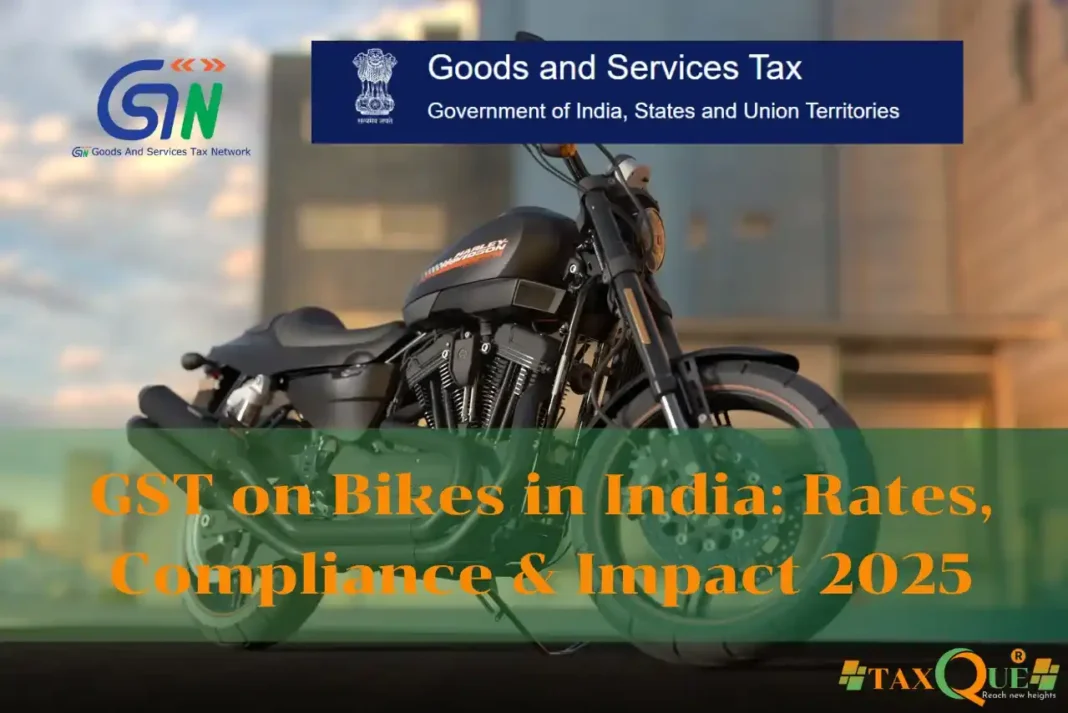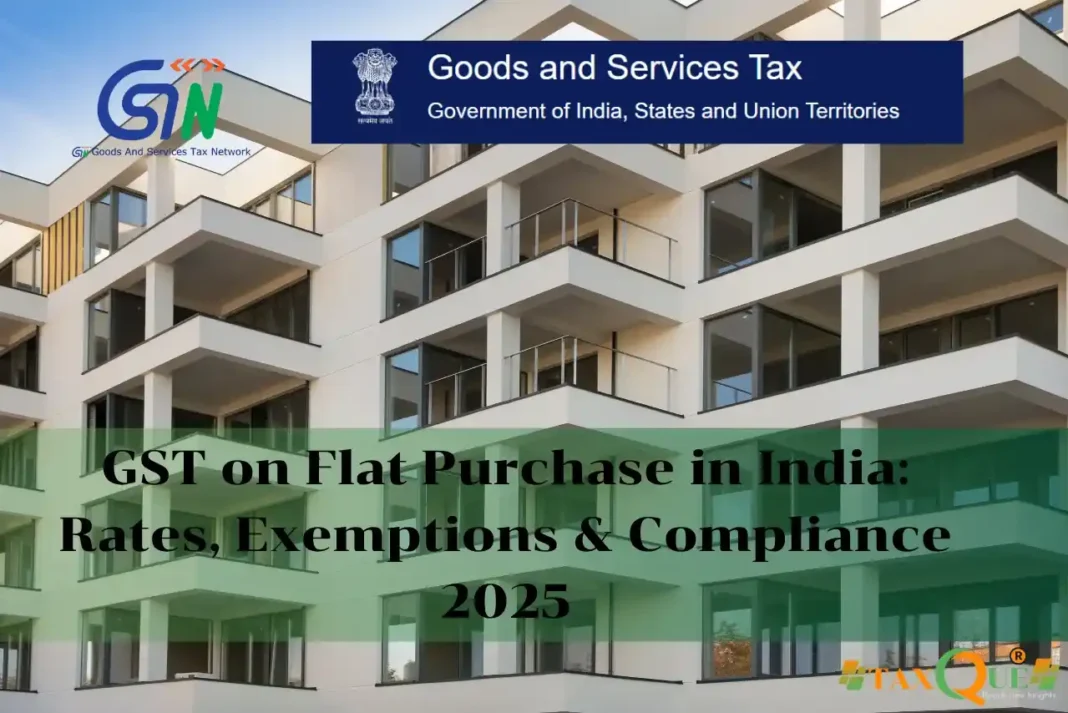Introduction
Understanding GST on bikes is crucial for businesses and consumers in India navigating the Goods and Services Tax (GST) regime, effective since July 1, 2017. Bikes, a primary mode of transport, attract specific GST rates based on engine capacity and fuel type, impacting pricing and compliance for manufacturers and retailers in cities like Patna, Bangalore, and Hyderabad. This blog provides a comprehensive guide on GST on bikes in 2025, detailing rates, HSN codes, compliance requirements, and effects on the two-wheeler industry as of June 3, 2025, and highlights how TaxQue simplifies GST processes for businesses during company registration or operations.
What Is GST on Bikes?
GST on bikes refers to the tax levied under India’s GST framework on the supply of two-wheelers, including motorcycles, scooters, and electric bikes, classified as goods under the CGST Act, 2017. GST replaced a pre-GST tax structure (excise duty ~12.5%, VAT ~12–15%, totaling ~30%) with tiered rates, administered by the GST Council. Rates vary from 5% for electric bikes to 31% for high-capacity bikes, affecting costs, compliance, and input tax credit (ITC) eligibility for businesses, especially during company registration in Patna or Bangalore.
1. GST Rates and HSN Codes for Bikes
Below is a table summarizing GST on bikes rates and HSN codes for 2025:
| Bike Type | GST Rate | HSN Code | Details |
|---|---|---|---|
| Non-Electric Bikes (≤350cc) | 28% | 8711 | Includes commuter bikes (e.g., Hero Splendor, Honda CB Shine). Intra-state: 14% CGST + 14% SGST; Inter-state: 28% IGST. |
| Non-Electric Bikes (>350cc) | 31% (28% + 3% cess) | 8711 | Premium bikes (e.g., Royal Enfield Classic 350). Intra-state: 14% CGST + 14% SGST + 1.5% cess each; Inter-state: 31% IGST. |
| Electric Bikes | 5% | 8711 | All electric two-wheelers (e.g., Ather 450X, Ola S1). Intra-state: 2.5% CGST + 2.5% SGST; Inter-state: 5% IGST. |
| Bike Spare Parts | 28% | 8714 | Includes engines, brakes, tyres, batteries. |
| Helmets | 18% | 6506 | Safety gear for riders. |
| Two-Wheeler Insurance | 18% | 9971 | Mandatory insurance premiums. |
- Non-Electric Bikes: Bikes up to 350cc (e.g., Hero HF Deluxe at 97.2cc) face 28% GST; those above 350cc (e.g., KTM Duke 390) incur an additional 3% cess, totaling 31%. For a ₹1,00,000 bike (≤350cc), GST is ₹28,000, making the ex-showroom price ₹1,28,000.
- Electric Bikes: Taxed at 5% since August 1, 2019 (37th GST Council), reduced from 12%, to promote eco-friendly transport. A ₹1,50,000 electric bike incurs ₹7,500 GST, totaling ₹1,57,500.
- Accessories & Insurance: Spare parts (28%) and helmets (18%) add to ownership costs. Insurance premiums, mandatory under the Motor Vehicles Act, 1988, attract 18% GST (e.g., ₹1,800 on a ₹10,000 premium).
- Note: As of June 3, 2025, rates remain unchanged per the 55th GST Council (December 21, 2024). Industry demands, voiced by SIAM and manufacturers like Honda, for reducing the 28% rate to 18% to boost sales are pending.
2. Compliance and Input Tax Credit (ITC)
GST on bikes compliance involves:
- GST Registration: Mandatory for businesses with turnover above ₹40 lakh (goods) or ₹20 lakh (services) in normal states like Bihar, or ₹20 lakh/₹10 lakh in special category states (e.g., Assam), via the GST portal.
- Invoicing: Invoices must include GSTIN, HSN code (8711 for bikes, 8714 for parts), and GST amount (5%, 28%, or 31%). Intra-state splits into CGST + SGST; inter-state uses IGST.
- ITC Eligibility: ITC is generally unavailable for bikes under Section 17(5)(a) of CGST Act, except for:
- Businesses supplying bikes (e.g., dealers claiming ₹28,000 ITC on a ₹1,00,000 bike).
- Bike taxi/rental services (e.g., Rapido).
- Driving schools using bikes for training.
- Reverse Charge Mechanism (RCM): If bikes or services (e.g., repairs) are bought from unregistered suppliers, the registered buyer pays GST under RCM (e.g., 28% on a ₹10,000 bike part), claiming ITC later.
- E-Way Bills: Required for inter-state bike transport above ₹50,000, using state codes (e.g., 29 for Karnataka).
- Returns Filing: Report transactions in GSTR-1 (sales) and GSTR-3B (summary) monthly/quarterly, ensuring correct HSN and state codes.
- Penalties: Non-compliance incurs ₹10,000–₹25,000 fines, 18% interest, or legal action.
3. Impact on Businesses, Consumers, and the Two-Wheeler Industry
The GST on bikes has reshaped India’s two-wheeler market:
- Pricing: The 28% rate for bikes ≤350cc (down from ~30% pre-GST) slightly reduced prices (e.g., Hero HF Deluxe dropped from ₹60,260 to ~₹41,545 post-GST), but the 31% rate for >350cc bikes increases costs (e.g., ₹31,000 GST on a ₹1,00,000 Royal Enfield). Electric bikes at 5% are more affordable, boosting sales (e.g., Ather 450X reduced by ₹14,000).
- Consumer Sentiment: X posts criticize the 28% rate, labeling bikes as “luxury items” despite their use by plumbers, carpenters, and the middle class, urging reductions to 18%.
- Industry Challenges: High GST rates (28–31%) and BS6 emission norms (since April 2020) have reduced sales, with FY24 wholesales at 1,79,74,365 units (13.3% growth) but below pre-COVID peaks. SIAM and manufacturers like Hero, Bajaj, and Honda advocate for lower rates to spur demand.
- Electric Vehicle Growth: The 5% GST rate and subsidies (e.g., Delhi’s ₹5,500 e-cycle incentive) drive electric bike adoption, with the market projected to grow 40% by 2028.
- Business Benefits: ITC for dealers and simplified logistics (fewer state barriers) reduce costs, but ITC restrictions for end-users and 18% insurance GST increase ownership expenses.
- Company Registration: Two-wheeler businesses registering in Bangalore or Patna must align GSTINs with state codes (29, 10) and assess turnover for GST registration (₹40/20 lakh).
TaxQue simplifies GST on bikes compliance with expert support for GST registration, ITC claims, and return filing. Visit TaxQue’s GST compliance guide or company registration services for seamless solutions.
FAQs
1. What is the GST rate on bikes in India?
The GST on bikes is 28% for non-electric bikes up to 350cc, 31% (28% + 3% cess) for those above 350cc, and 5% for electric bikes under HSN 8711.
2. Are electric bikes taxed differently under GST?
Yes, electric bikes attract a 5% GST rate, significantly lower than 28–31% for non-electric bikes, to promote eco-friendly transport.
3. Can businesses claim ITC on GST paid for bikes?
ITC is unavailable for personal-use bikes but can be claimed by dealers, bike taxi services, or driving schools under specific conditions.
4. Does RCM apply to bike purchases?
Yes, if bought from unregistered suppliers, registered buyers pay GST (e.g., 28%) under RCM, claiming ITC later.
5. How does TaxQue assist with GST on bikes compliance?
TaxQue provides tools for GSTIN verification, RCM compliance, and return filing for two-wheeler businesses. Explore TaxQue’s compliance services.
Conclusion
GST on bikes in India, ranging from 5% for electric bikes to 31% for premium motorcycles, shapes pricing and compliance in the two-wheeler industry. While electric bikes benefit from low rates, high 28–31% rates for non-electric bikes challenge affordability, prompting industry calls for reductions. Businesses in Patna, Bangalore, and beyond leverage ITC and streamlined logistics but face compliance complexities. As of June 3, 2025, platforms like TaxQue enhance GST on bikes compliance with expert tools for registration, invoicing, and return filing. Stay compliant, optimize costs, and navigate India’s two-wheeler market confidently in 2025.





